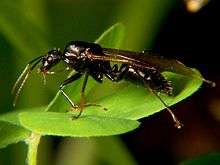Black carpenter ant
| Black carpenter ant | |
|---|---|
 | |
| Camponotus pennsylvanicus (winged male) | |
| Scientific classification | |
| Kingdom: | Animalia |
| Phylum: | Arthropoda |
| Class: | Insecta |
| Order: | Hymenoptera |
| Family: | Formicidae |
| Subfamily: | Formicinae |
| Genus: | Camponotus |
| Species: | C. pennsylvanicus |
| Binomial name | |
| Camponotus pennsylvanicus (De Geer, 1773) | |

The black carpenter ant (Camponotus pennsylvanicus) is a species of carpenter ant.
Appearance
C. pennsylvanicus can be distinguished from other carpenter ant species by the dull black color of the head and body, and by whitish or yellowish hairs on the abdomen. All castes of this species (including the major and minor workers, queens, and males) are black or blackish. Colonies' workers are not all the same size (polymorphism). The antennae are elbowed, usually with six to 13 segments.
Behavior
Black carpenter ants are known to forage up to 100 yards in search of food. Workers are most active at night, traveling from their nest to a food source following trails. They do establish chemical (pheromone) trails. The ants produce crackling sounds that can often be heard near a large nest. A large colony can have thousands of individuals. The black carpenter ant does not sting, but the larger workers can administer a sharp bite, which can become further irritated by the injection of formic acid, which they produce.
Control measures
In their natural environment, carpenter ants nest in dead trees and other dead wood. This enhances decay, which has ecological benefits. However, the ant achieves pest status when a colony invades the wood of a house or other structure, damaging its structural integrity.[1]
Since they favor moist wood as a habitat, any condition that promotes moisture should be eliminated to prevent infestation. The easiest of these is keeping gutters clear so water does not run down the side of the structure or gain entry. Moist wood is much easier to chew. The ants do not eat the wood, but remove it to create galleries for their activities. The galleries run parallel to the grain, as they are created in the softer, nonlignin portions of the timber. The galleries have a sandpaper-like feel, due to fecal remnants, but the mud tubes produced by termites will not be present.
References
- ↑ http://lancaster.unl.edu/pest/resources/carpant004.shtml Carpenter Ant Management
External links
 Media related to Camponotus pennsylvanicus at Wikimedia Commons
Media related to Camponotus pennsylvanicus at Wikimedia Commons